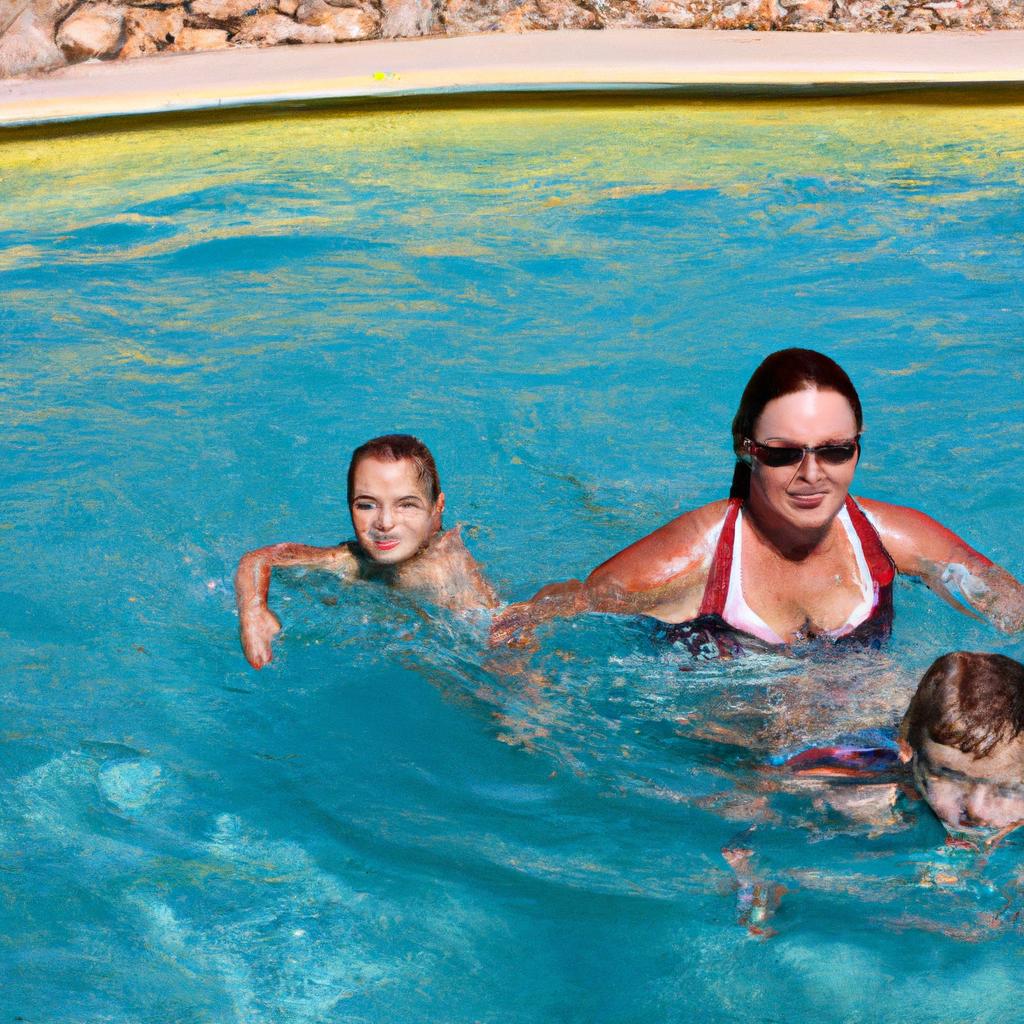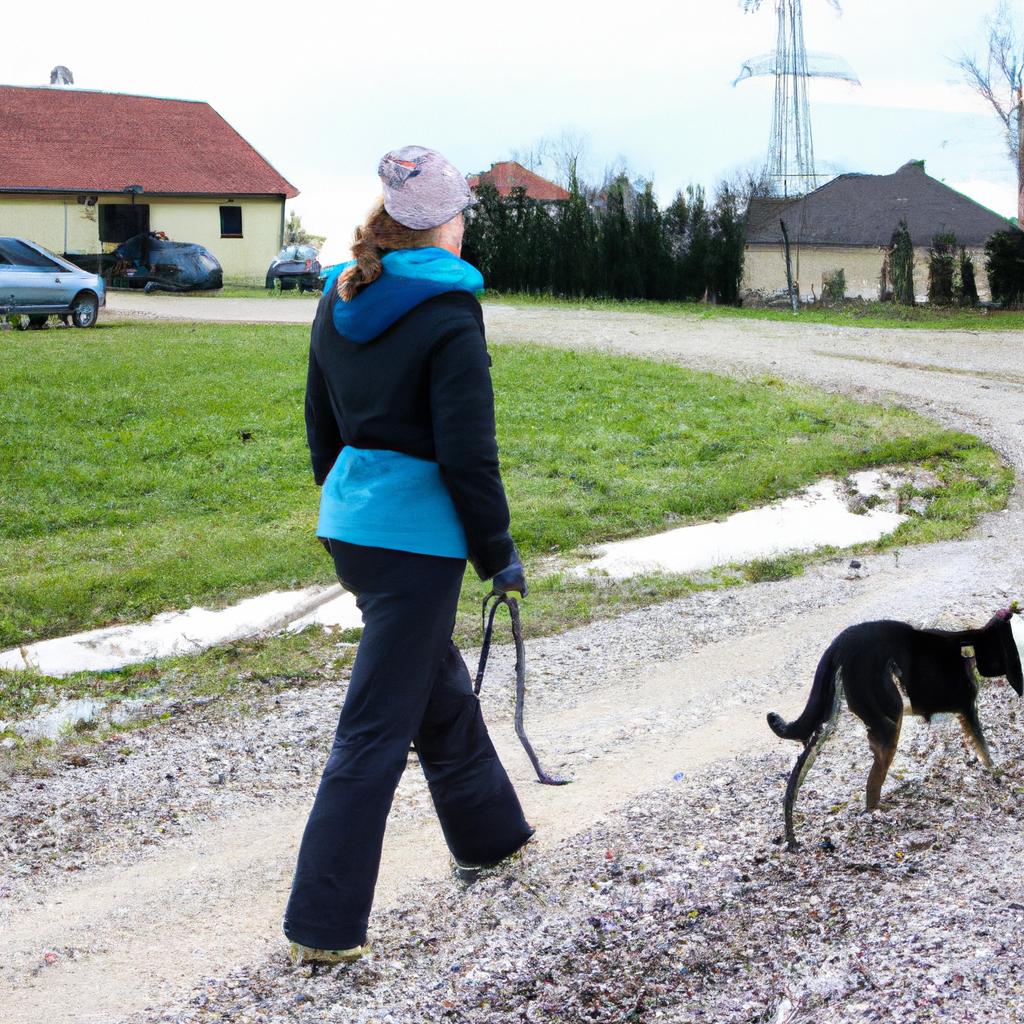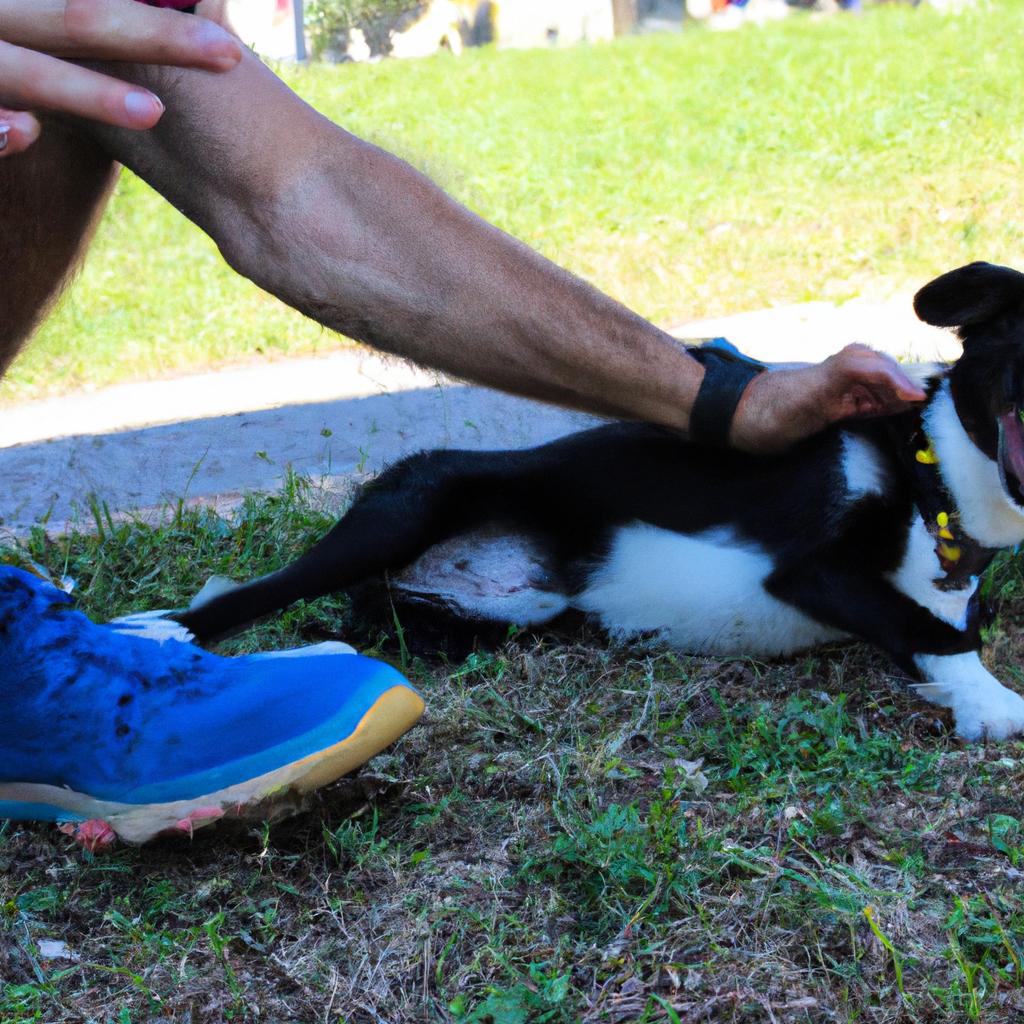Creating a beautiful garden area can greatly enhance the overall appeal and experience of a family-run guesthouse. This article aims to explore the concept of designing a pet-friendly oasis within such establishments, focusing on how it can provide an inviting atmosphere for guests while accommodating their furry companions. By implementing suitable landscaping techniques and incorporating elements that cater to both humans and animals alike, guesthouses can create a serene outdoor space that promotes relaxation, recreation, and harmonious coexistence.
Consider the hypothetical case study of a quaint bed and breakfast nestled in the countryside. The owners have noticed an increasing number of guests seeking accommodation with their pets. Recognizing this trend, they decide to transform their existing garden into a pet-friendly oasis. This not only caters to the needs of pet-owning guests but also presents an opportunity to attract new clientele who prioritize traveling with their beloved animal companions. Through careful planning and implementation, this guesthouse successfully creates an enchanting garden area where pets are welcomed, allowing families to enjoy quality time together surrounded by nature’s beauty.
Planning the Garden Layout
To create a beautiful garden area that caters to both guests and their pets, careful planning of the layout is crucial. One example of an effective garden layout is seen at Green Meadows Guesthouse, where they have successfully designed a pet-friendly oasis for their visitors. By following these steps and considering various factors, you can achieve a similar result.
Firstly, it is important to assess your available space and consider how you want to use it. Think about whether you want separate areas for different activities or if you prefer a more open design. For instance, at Green Meadows Guesthouse, they have divided their garden into three sections: one for relaxation, another for games and playtime with pets, and a third for dining al fresco. This division allows guests and their furry companions to enjoy different aspects of the garden while maintaining harmony between them.
Secondly, incorporating elements that provide shade and shelter should be prioritized. Not only do trees and pergolas add visual interest to the garden but they also offer protection from sun exposure or unexpected rain showers. Additionally, by strategically placing benches or seating areas under shaded spots, both humans and animals can comfortably rest without being exposed to direct sunlight.
Next, creating pathways throughout the garden helps guide guests in exploring different areas while keeping them away from delicate plants. These paths can be made using materials such as gravel or stepping stones which blend well with natural surroundings. Providing clear signage along the pathways not only enhances navigation but also adds a touch of professionalism to your guesthouse’s outdoor ambiance.
Lastly, adding water features can greatly enhance the overall appeal of the garden while providing opportunities for pets to cool off during hot summer days. A small pond or fountain can serve as a focal point and attract birds or other wildlife that will surely captivate visitors’ attention.
Incorporating these elements into your garden layout will contribute significantly towards creating an inviting atmosphere for both guests and their pets. By considering the available space, providing shade and shelter, creating pathways, and adding water features, you can ensure that your garden becomes a cherished oasis for all who visit.
Transitioning into the subsequent section on “Selecting Pet-Safe Plants,” it is important to carefully choose vegetation that will not pose any harm to animals while enhancing the beauty of the garden area.
Selecting Pet-Safe Plants
Imagine this scenario: You have just arrived at a family-run guesthouse, seeking relaxation and tranquility. As you step into the garden area, you are immediately drawn to its beauty and charm. The carefully planned layout seamlessly blends with nature, while catering to the needs of the resident pets and providing an inviting space for guests. In this section, we will explore how to design a pet-friendly garden layout that enhances the overall appeal of your family-run guesthouse.
To create a truly remarkable pet-friendly oasis, consider incorporating the following elements into your garden design:
-
Defined Zones: Create designated areas within the garden for different activities such as playtime, relaxation, and exercise. This not only helps in organizing the space but also allows both pets and guests to coexist comfortably.
-
Sensory Stimulation: Include various features like water fountains or shallow pools for dogs to splash around in, bird feeders to attract colorful visitors, and aromatic plants such as lavender or mint to engage pets’ senses.
-
Safe Boundaries: Install secure fencing around the perimeter of the garden to ensure that pets can roam freely without escaping or encountering potential dangers from nearby roads or neighboring properties.
-
Shaded Retreats: Provide shaded spots through strategically placed trees, pergolas covered with climbing plants, or even purpose-built structures like gazebos where both pets and humans can seek respite from the sun during hot summer days.
In addition to these design elements, it is crucial to select pet-safe plants when creating your garden oasis at the guesthouse. Incorporating plant species that are non-toxic and pose no harm if accidentally ingested by curious animals ensures their well-being remains uncompromised.
| Plant Name | Category | Height Range |
|---|---|---|
| Calendula | Annual Flower | 12-24 inches |
| Catnip | Herb | 12-36 inches |
| Camellia | Evergreen Shrub | 6-15 feet |
| Sunflowers | Annual Flower | 3-10 feet |
By carefully selecting pet-safe plants and incorporating these design elements, you can create a garden that is not only visually appealing but also provides a safe and enjoyable environment for pets and guests alike. In the upcoming section on “Implementing Safety Measures,” we will further explore how to ensure the well-being of your furry companions by implementing additional precautions within the garden space.
Implementing Safety Measures
Having selected pet-safe plants for your garden area, it is crucial to implement safety measures that will ensure a harmonious environment for both pets and guests. By taking proactive steps to create a secure space, you can enhance the experience of your visitors while providing peace of mind.
Creating a Safe Haven:
To establish a truly pet-friendly oasis at your family-run guesthouse, consider implementing the following safety measures:
-
Fencing: Install sturdy fencing around the garden perimeter to prevent animals from wandering off or entering restricted areas. Opt for materials such as vinyl or metal that are durable and resistant to chewing or clawing.
-
Secure Gates: Make sure all gates leading into the garden area have locks or latches that are inaccessible to pets. This will provide an additional layer of security, ensuring that furry friends cannot escape when unattended.
-
Hazard-Free Design: Regularly inspect the garden for potential hazards such as sharp edges, toxic substances, or small objects that could be harmful if ingested by curious pets. Remove any dangerous items promptly and replace them with safe alternatives.
-
Signage: Place clear signs throughout the garden indicating designated walking paths and specific restrictions, such as areas where pets should remain on leash or where they are not allowed altogether. These visual cues will help guide both guests and their four-legged companions within the premises.
Table – Pet-Friendly Garden Features:
| Feature | Benefit | Example |
|---|---|---|
| Padded play area | Provides cushioning for active play | A soft turf surface minimizes injuries during energetic games |
| Accessible water sources | Keeps pets hydrated throughout their visit | Strategically placed water fountains encourage regular drinking |
| Shaded spots | Offers relief from sun exposure | Large trees provide natural shade for relaxation |
| Pet waste stations | Promotes cleanliness and hygiene | Conveniently located waste bins encourage responsible disposal |
By incorporating these safety measures, you can transform your garden into a secure haven where pets and guests alike can enjoy their stay. With the right precautions in place, your family-run guesthouse will undoubtedly become known for its pet-friendly environment.
As we continue our journey toward creating an ideal space for your furry friends, let us now explore how to design shaded areas within your garden that provide respite from the sun’s rays.
Creating Shaded Areas
While implementing safety measures is crucial in creating a pet-friendly oasis, providing shaded areas is equally important to ensure the comfort and well-being of both pets and guests. Let’s explore how you can create inviting spaces that offer respite from the sun.
To illustrate this point, consider a scenario where you have implemented safety measures such as secure fencing and non-toxic plants within your garden area. However, without adequate shade, pets and their owners may find it challenging to spend prolonged periods outdoors during hotter months. By incorporating shaded areas into your garden design, you not only enhance the overall experience for your furry friends but also provide an enticing space for relaxation and enjoyment.
One effective way to introduce shading elements is through landscaping techniques that utilize natural features like trees or shrubs strategically placed throughout the garden. These green havens not only provide shelter from direct sunlight but also contribute to enhancing the aesthetic appeal of your outdoor space. Additionally, installing pergolas or gazebos with built-in retractable shades can offer flexible options for controlling exposure to the sun at different times of the day.
Consider these benefits when creating shaded areas:
- Protecting pets from overheating.
- Offering a comfortable environment for guests to unwind.
- Promoting extended outdoor stays by mitigating excessive heat.
- Enhancing visual appeal by incorporating natural elements into the landscape design.
Table – Benefits of Shaded Areas:
| Benefit | Description |
|---|---|
| Protection | Shaded areas shield pets and guests from harmful UV rays, reducing the risk of sunburns and heat-related illnesses. |
| Comfort | Providing cool spots allows pets to rest comfortably while enjoying time outdoors with their owners. Guests will appreciate having shaded retreats where they can relax amid nature’s beauty. |
| Extended Outdoor Enjoyment | With ample shade available, both pets and guests can spend more time outside, engaging in activities or simply soaking up the serene ambiance. |
| Aesthetically Pleasing Spaces | Incorporating shaded areas into your garden design adds depth and texture to the overall visual appeal of the outdoor space. It creates a harmonious blend between nature’s elements and man-made structures, enhancing its charm. |
Now that we have explored the importance of creating shaded areas within your pet-friendly oasis, let us delve into another aspect – adding pet-friendly features that will further enhance this tranquil environment for your furry friends.
Adding Pet-Friendly Features
When it comes to creating a beautiful garden area that is both pet-friendly and inviting for your guests, providing shaded areas is crucial. Not only do these spaces offer respite from the sun’s rays, but they also create a tranquil ambiance where guests can relax with their furry companions. Let’s explore some effective ways to incorporate shaded areas into your family-run guesthouse garden.
One example of an excellent shaded area design is the use of pergolas covered in climbing plants such as jasmine or wisteria. These structures not only provide shade but also add a touch of elegance to the overall aesthetics of the garden. Guests can enjoy sitting beneath these fragrant vines while reading a book or sipping on a refreshing drink. Additionally, installing retractable awnings over seating areas allows flexibility in adjusting the amount of shade depending on the time of day and weather conditions.
To further enhance the appeal of your shaded areas, consider incorporating elements that evoke positive emotions among your guests. Here are some ideas:
- Hang wind chimes that produce soothing sounds when there’s a gentle breeze.
- Place comfortable outdoor cushions and pillows on seating benches or hammocks.
- Utilize soft lighting options like string lights or lanterns for cozy evenings.
- Install misters or small water fountains nearby to create a cooling effect during hot summer days.
In addition to these ideas, you may find it helpful to plan out different zones within your garden using a table format:
| Zone | Features | Purpose |
|---|---|---|
| A | Covered gazebo | Ideal spot for socializing and hosting small gatherings |
| B | Seating under shade trees | Perfect for solo relaxation or spending quality time |
| C | Pet play area | Dedicated space where pets can roam freely |
| D | Outdoor dining set | Enjoying meals amidst nature while staying protected |
By creating these different zones, you provide guests with versatile spaces that cater to their specific needs and preferences. Whether they prefer socializing in a covered gazebo or spending quiet moments under the shade of trees, your garden will offer something for everyone.
Transitioning seamlessly into the next section about “Maintaining a Clean and Inviting Space,” it is essential to ensure that your shaded areas remain clean and well-maintained.
Maintaining a Clean and Inviting Space
With the incorporation of pet-friendly features in your garden area, it is essential to ensure that the space remains clean and inviting for both your human guests and their furry companions. By following a few key practices, you can maintain a pristine environment that enhances the overall experience of staying at your family-run guesthouse.
To illustrate the importance of maintaining cleanliness within the garden area, consider this hypothetical scenario. Imagine two families visiting your guesthouse with their pets. One family arrives to find well-maintained garden beds, neatly trimmed hedges, and an absence of any stray waste or debris. The other family encounters unkempt flowerbeds, overgrown grass, scattered trash, and unattended pet waste. Naturally, the first family will feel more welcomed and comfortable while exploring your beautiful gardens.
To keep your garden area clean and appealing for all visitors – both human and animal – here are some tips to follow:
-
Regular maintenance:
- Trim hedges, mow lawns, and prune plants on a consistent basis.
- Remove fallen leaves or debris from pathways promptly.
- Conduct routine inspections to identify potential hazards or issues requiring attention.
-
Waste management:
- Provide designated disposal bins for pet waste throughout the garden area.
- Encourage guests to pick up after their pets by placing informative signage.
- Regularly empty bins to prevent overflowing or unpleasant odors.
-
Pest control:
- Employ natural pest control methods such as companion planting or biological controls.
- Inspect plants regularly for signs of pests or diseases.
- Promptly address any infestations using appropriate remedies recommended by professionals.
-
Seasonal adjustments:
- Adapt your maintenance routines based on seasonal changes.
- Modify watering schedules and adjust plant selection to suit weather conditions.
- Consider using protective covers during extreme weather events.
To further emphasize the importance of maintaining a clean garden area, below is a table illustrating the potential impact of an unkempt space versus a well-maintained one:
| Aspect | Unkempt Garden Area | Well-Maintained Garden Area |
|---|---|---|
| Guest Satisfaction | Low due to untidy appearance and potential hazards | High as it offers a visually appealing and safe environment |
| Pet Comfort | Decreased comfort with possible exposure to pests | Enhanced comfort in a pest-free zone |
| Repeat Bookings | Less likely to receive return visits from dissatisfied guests | Increased likelihood of repeat bookings |
| Online Reviews | Negative reviews highlighting uncleanliness or hazards | Positive reviews praising cleanliness and overall ambiance |
By implementing effective maintenance practices within your garden area, you can create an inviting atmosphere for both human guests and their pets. This attention to detail will not only enhance guest satisfaction but also contribute to positive online reviews and increased business opportunities. Embrace these strategies, adapt them seasonally, and continue showcasing your commitment towards providing a pet-friendly oasis at your family-run guesthouse.
 Avalonon Sea
Avalonon Sea



